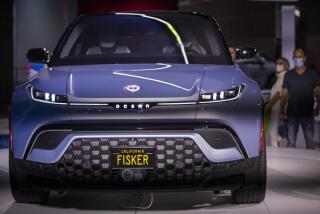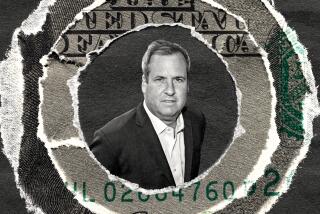Feathers Fly in Hollister After Sparrow’s Nose Dive
It’s a safe bet that there aren’t many fans of the Hanagan family left in the Northern California city of Hollister.
Certainly not as many as there were when Mike Hanagan and his son Tom first came up with their Corbin Motors Inc. venture in the late 1990s. They proceeded to fill the locals’ heads with dreams of turning Hollister into the world manufacturing center of a snazzy electric car called the Sparrow, and accepted thousands of dollars in investments for their fledgling enterprise from their neighbors.
The townspeople embraced the venture for a while. They basked in reflected glory when the ovate three-wheeled runabout landed a cameo appearance in an “Austin Powers” movie. They watched prospective buyers and dealers fly in from all over the country to be shuttled around town in Tom Hanagan’s luxury Bentley. They bought into the Hanagans’ projections of millions of dollars of profit in years to come.
When the dream died -- the company went bankrupt in March after building scarcely 300 cars -- it seems much of the city came down to earth with a thud.
As the scale of the failure became clear, the locals, among other investors, started complaining loudly about the Hanagans’ alleged mismanagement of the company. The local newspaper, the weekly Pinnacle, chronicled the spreading rage and, arguably, helped stoke it.
The 18,300-circulation newspaper freely quoted investors calling the Hanagans crooks and liars. At one point it reported, entirely erroneously, that Tom Hanagan had admitted to holding $6.8 million in Corbin Motors shares in a family account in Florida. This, in turn, fueled speculation that the family had systematically drained investors’ funds to pay for what the Pinnacle termed their “extravagant lifestyles.”
The Hanagans contend that the Pinnacle’s articles made a bad situation worse by spreading the incorrect impression that the company had failed not for legitimate business reasons, but because of outright thievery.
They also complain that the newspaper’s articles were rife with mistakes. The Pinnacle reported, for example, that Mike Hanagan paid himself a salary of more than $180,000 a year at Corbin, while he says he worked for free and lost, by his reckoning, more than $3 million of his own capital in the failed venture.
The Hanagans acknowledge that they failed to bring these errors to the newspaper’s attention until last week, when they sent the Pinnacle a five-page retraction demand covering articles as far back as April 2002. (The newspaper says it would have corrected any errors had it known of them at the time.)
But the Hanagans also raise the legitimate question of why the Pinnacle, while recording the anguish and bitterness of local investors in what it hinted might be one of the “biggest financial scandals in the history of San Benito County,” never got around to mentioning one fact that it knew beyond dispute: Among Corbin Motors’ aggrieved shareholders were the newspaper’s two owners.
Pinnacle Publisher Tracie L. Cone, who invested $18,000 with her partner, Editor in Chief Anna Marie dos Remedios, in 2000, says she can’t now remember whether the paper ever disclosed the couple’s investment in print. But no such disclosure appears in any article about Corbin available on the newspaper’s online database. And certainly none is contained in any of the stories the Pinnacle ran after April 2002 detailing the company’s decline and fall and wholesaling the accusations of fraud. At least one of these pieces bore Cone’s own byline.
Cone told me she doesn’t believe her readers needed to know about the investment. “If we were making statements that created a situation that we were going to benefit financially from --then absolutely, we should have disclosed,” she says.
On the contrary, she says she and dos Remedios have written the matter off. “We haven’t filed a claim with Bankruptcy Court,” she says. “We figure we took a gamble and it didn’t pan out.”
*
Lack of Disclosure
Under the circumstances, though -- a small newspaper in a small city covering the biggest local business story in years -- this is not even a close call.
Leaving aside the basic dishonesty inherent in the practice of referring in print to “investors” without revealing that the category includes themselves, Cone’s and dos Remedios’ investment loss in Corbin Motors may have colored their coverage of the company’s downfall, possibly without their even being aware of it.
The only way to inoculate themselves to the charge that they may have a conflict of interest, which the Hanagans do indeed contend, is to have been open about it.
And the fact remains that some of the things the Pinnacle has said about the Corbin bankruptcy could well end up financially benefiting Cone and dos Remedios.
By reporting allegations that the Hanagans have cached corporate funds in personal accounts, for example, the newspaper could be helping to feed a nascent shareholder effort to fund an independent search for assets. That search, which might result in a financial recovery for the early backers of the company, would cost at least $200,000 -- but will only take place if enough investors and creditors believe it will be worthwhile to put up the front money.
At this writing, it’s unknown whether any hard evidence exists that the Hanagans spent any corporate funds on personal expenses. It’s possible that bankruptcy officials and state securities regulators eventually will uncover evidence of fraud. “That’s what we’re looking at right now,” says John W. Richardson, the company’s bankruptcy trustee.
But as yet, they haven’t produced any such proof.
The Hanagans insist that although they sometimes used the same credit cards for company and personal purposes, they rigorously kept track of which was which and paid for any personal expenses themselves. The documentation was “very specific and correct,” Tom Hanagan says, and will be “clear as day” to the investigators.
*
Bad Choice of Investors
It’s possible, alternatively, that the Hanagans’ real mistake was accepting investments from people in a position to pass them on the street day in and day out in a small city of 34,000 souls. When an investment goes under, it’s only natural for the losers to cast a resentful eye on the managers, and it’s not a happy situation when the former are forced to watch the latter drive on in their luxury automobiles and maintain their shopping habits at the same grand stores.
“If a person invests and loses their money, they’re angry and upset and disappointed,” Mike Hanagan says. “Add the accusation that people stole your money, and they feel betrayed too. That’s where the hate comes in.”
If that’s so, the die was cast soon after Mike Hanagan hit on the idea of capitalizing on environmental fervor and the availability of venture capital at the start of the dot-com boom by building an ecologically friendly car.
Hanagan was already well-known in the motorcycle world as Mike Corbin, the owner of Corbin-Pacific Inc., a prominent private maker of motorcycle saddles and accessories. (He had picked the Corbin name out of the air years earlier as a trademark, and used the two names interchangeably.) With his son Tom, also known as Tom Corbin, he set up Corbin Motors to exploit some novel electric motor technologies, and distributed a business plan to investors.
In short order, however, it became evident that the Sparrow was a lemon. It was top-heavy and therefore prone to falling over in a sharp turn. Its battery system was too weak to drive as far as its designers promised between charges. At a South Dakota motorcycle rally in 1999, a rainstorm shorted out the electrical system of a prototype model, sending the driverless vehicle careening around the fairgrounds, headlights ablaze, until it smashed into a truck.
While the company was trying to fix the Sparrow’s flaws, the dot-com boom faded. Investment capital became harder to come by. Then the economy turned sour, hurting sales of a $14,000 one-seat vehicle that was manifestly a discretionary buy.
By 2002, Corbin Motors had amassed piles of lawsuits from stiffed suppliers and disaffected Sparrow owners. “The company probably geared up too fast and never solved its technical problems well enough,” Mike Hanagan says.
The Pinnacle ran a comprehensive article in April that year detailing Corbin Motors’ overly optimistic sales projections, troubles with the cars, litigation with suppliers and other red flags.
In early 2003, state securities regulators started working on a lawsuit, eventually filed in May, alleging that Corbin had illegally issued unregistered stock by selling to investors who did not meet the legal standard of $200,000 a year in income or net worth of $1 million. The suit also contended that the Hanagans misrepresented the financial condition of the company to investors.
State officials say they are still in the process of assembling evidence to back up their allegations. The Hanagans, for their part, say they can document that every buyer signed certifications that they met the standard, and they deny that they misrepresented Corbin’s condition.
After the company’s bankruptcy filing, the Pinnacle’s articles grew progressively more negative. Its single most damaging assertion, first made on May 1 and repeated in a later article, was that Tom Hanagan had admitted at a court hearing that the family was holding Corbin Motors stock through a Florida company worth $6.8 million. The report may have contributed to investors’ frenzied speculation that, at last, a hoard of cash could be seized to restore losses.
*
Shares Held by Family
But what Hanagan had said was that the family holding was 6.8 million shares of Corbin stock, which like all other shares had been rendered worthless by the bankruptcy.
Laura Rasmussen, a lawyer for several investors whose direct questioning had elicited the statement from Hanagan, herself believes that “probably some people in the back of the courtroom simply misunderstood” what was said, and repeated their misconception to the newspaper.
That said, Rasmussen remains convinced that the Hanagans have squirreled away millions in corporate funds. “I’ve found the Pinnacle to be very reserved,” she says of the coverage.
The Hanagans say the record eventually will bear them out. “The company spent every penny it got,” says Tom Hanagan, “on payroll, marketing, business expenses -- and building cars.”
*
Michael Hiltzik can be reached at [email protected].
More to Read
Inside the business of entertainment
The Wide Shot brings you news, analysis and insights on everything from streaming wars to production — and what it all means for the future.
You may occasionally receive promotional content from the Los Angeles Times.











